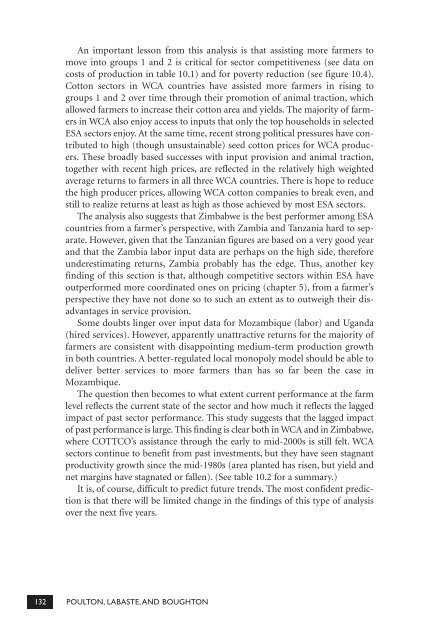Organization and Performance of Cotton Sectors in Africa ... - infoDev
Organization and Performance of Cotton Sectors in Africa ... - infoDev
Organization and Performance of Cotton Sectors in Africa ... - infoDev
You also want an ePaper? Increase the reach of your titles
YUMPU automatically turns print PDFs into web optimized ePapers that Google loves.
An important lesson from this analysis is that assist<strong>in</strong>g more farmers tomove <strong>in</strong>to groups 1 <strong>and</strong> 2 is critical for sector competitiveness (see data oncosts <strong>of</strong> production <strong>in</strong> table 10.1) <strong>and</strong> for poverty reduction (see figure 10.4).<strong>Cotton</strong> sectors <strong>in</strong> WCA countries have assisted more farmers <strong>in</strong> ris<strong>in</strong>g togroups 1 <strong>and</strong> 2 over time through their promotion <strong>of</strong> animal traction, whichallowed farmers to <strong>in</strong>crease their cotton area <strong>and</strong> yields. The majority <strong>of</strong> farmers<strong>in</strong> WCA also enjoy access to <strong>in</strong>puts that only the top households <strong>in</strong> selectedESA sectors enjoy. At the same time, recent strong political pressures have contributedto high (though unsusta<strong>in</strong>able) seed cotton prices for WCA producers.These broadly based successes with <strong>in</strong>put provision <strong>and</strong> animal traction,together with recent high prices, are reflected <strong>in</strong> the relatively high weightedaverage returns to farmers <strong>in</strong> all three WCA countries. There is hope to reducethe high producer prices, allow<strong>in</strong>g WCA cotton companies to break even, <strong>and</strong>still to realize returns at least as high as those achieved by most ESA sectors.The analysis also suggests that Zimbabwe is the best performer among ESAcountries from a farmer’s perspective, with Zambia <strong>and</strong> Tanzania hard to separate.However, given that the Tanzanian figures are based on a very good year<strong>and</strong> that the Zambia labor <strong>in</strong>put data are perhaps on the high side, thereforeunderestimat<strong>in</strong>g returns, Zambia probably has the edge. Thus, another keyf<strong>in</strong>d<strong>in</strong>g <strong>of</strong> this section is that, although competitive sectors with<strong>in</strong> ESA haveoutperformed more coord<strong>in</strong>ated ones on pric<strong>in</strong>g (chapter 5), from a farmer’sperspective they have not done so to such an extent as to outweigh their disadvantages<strong>in</strong> service provision.Some doubts l<strong>in</strong>ger over <strong>in</strong>put data for Mozambique (labor) <strong>and</strong> Ug<strong>and</strong>a(hired services). However, apparently unattractive returns for the majority <strong>of</strong>farmers are consistent with disappo<strong>in</strong>t<strong>in</strong>g medium-term production growth<strong>in</strong> both countries. A better-regulated local monopoly model should be able todeliver better services to more farmers than has so far been the case <strong>in</strong>Mozambique.The question then becomes to what extent current performance at the farmlevel reflects the current state <strong>of</strong> the sector <strong>and</strong> how much it reflects the laggedimpact <strong>of</strong> past sector performance. This study suggests that the lagged impact<strong>of</strong> past performance is large. This f<strong>in</strong>d<strong>in</strong>g is clear both <strong>in</strong> WCA <strong>and</strong> <strong>in</strong> Zimbabwe,where COTTCO’s assistance through the early to mid-2000s is still felt. WCAsectors cont<strong>in</strong>ue to benefit from past <strong>in</strong>vestments, but they have seen stagnantproductivity growth s<strong>in</strong>ce the mid-1980s (area planted has risen, but yield <strong>and</strong>net marg<strong>in</strong>s have stagnated or fallen). (See table 10.2 for a summary.)It is, <strong>of</strong> course, difficult to predict future trends. The most confident predictionis that there will be limited change <strong>in</strong> the f<strong>in</strong>d<strong>in</strong>gs <strong>of</strong> this type <strong>of</strong> analysisover the next five years.132 POULTON, LABASTE, AND BOUGHTON
















